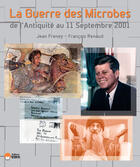Résumé:
From this highly informative book, rich in historical examples and anecdotes, one realizes that an endless war is still raging between microbes and men. The stories recounted here remind us of the past eras when both, the rich and poor paid heavily for infectious diseases and consequently had a... Voir plus
From this highly informative book, rich in historical examples and anecdotes, one realizes that an endless war is still raging between microbes and men. The stories recounted here remind us of the past eras when both, the rich and poor paid heavily for infectious diseases and consequently had a much shorter life expectancy than us. Scores of epidemics have left their mark on world history and often altered its course. Since millions of years, innumerable, ubiquitous, microscopic life forms have lived alongside and at times attacked human, animal and plant life. In the late 1960s, with the advent of efficient methods of diagnosis, development of protective sera and vaccines, therapeutic antibiotics, antivirals, antiparasitics, insecticides, etc., one believed that the war against microbes would fade out or even disappear. However, there was but a short truce. Since then, a good thirty-odd infectious agents have emerged or re-emerged and spread to occupy new geographical niches, for example, agents of legionellosis and mad cow disease, or viruses like Ebola, HIV, SARS, Nipah, Hendra, Chicungunya, West Nile, dengue fever, bird flu etc. Currently about one-third of human deaths are due infectious diseases. While man is often a victim of these diseases, particularly in the Southern hemisphere, he is also largely responsible for their spread. This is due to several reasons: changes in human life-style and social behavior, globalization and free trade, lack of adequate hygiene and epidemiological surveillance in some countries, as well as global warming that promotes spread of diseases and arthropod vectors. Moreover, man is also responsible for the dangerous use of microbial pathogenic agents in biological warfare or terrorism. The fight is on. This is what the two authors, Jean Freney and François Renaud, want to remind us of in Microbes at War . May this book find a wide audience among the well-informed as well as the simply curious.















